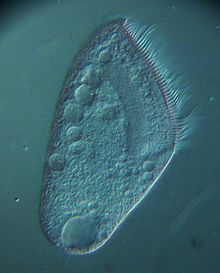
The alveolates are a group of protists, considered a major clade and superphylum within Eukarya. They are currently grouped with the stramenopiles and Rhizaria among the protists with tubulocristate mitochondria into the SAR supergroup.

Paramecium is a genus of eukaryotic, unicellular ciliates, commonly studied as a model organism of the ciliate group. Paramecium are widespread in freshwater, brackish, and marine environments and are often abundant in stagnant basins and ponds. Because some species are readily cultivated and easily induced to conjugate and divide, they have been widely used in classrooms and laboratories to study biological processes. The usefulness of Paramecium as a model organism has caused one ciliate researcher to characterize it as the "white rat" of the phylum Ciliophora.
A planula is the free-swimming, flattened, ciliated, bilaterally symmetric larval form of various cnidarian species and also in some species of Ctenophores, which are not related to cnidarians at all. Some groups of Nemerteans also produce larvae that are very similar to the planula, which are called planuliform larva. In a few cnidarian clades, like Aplanulata and the parasitic Myxozoa, the planula larval stage has been lost.
Skeletal eroding band (SEB) is a disease of corals that appears as a black or dark gray band that slowly advances over corals, leaving a spotted region of dead coral in its wake. It is the most common disease of corals in the Indian and Pacific Oceans, and is also found in the Red Sea.

Opalinata is a superclass of non-phagotrophic heterokonts that unites the classes Opalinea and Blastocystea, and is the sister group to Opalomonadea.

Conosa is a grouping of Amoebozoa. It is subdivided into three groups: Archamoeba, Variosea and Mycetozoa.
Karyorelictea is a class of ciliates in the subphylum Postciliodesmatophora. Most species are members of the microbenthos community, that is, microscopic organisms found in the marine interstitial habitat, though one genus, Loxodes, is found in freshwater.
''''' is a of karyorelictean ciliates, belonging to Loxodidae. It is the only known karyorelictean ciliate that lives in freshwater habitats.

The ciliates are a group of alveolates characterized by the presence of hair-like organelles called cilia, which are identical in structure to eukaryotic flagella, but are in general shorter and present in much larger numbers, with a different undulating pattern than flagella. Cilia occur in all members of the group and are variously used in swimming, crawling, attachment, feeding, and sensation.

Euplotes is a genus of ciliates in the subclass Euplotia. Species are widely distributed in marine and freshwater environments, as well as soil and moss. Most members of the genus are free-living, but two species have been recorded as commensal organisms in the digestive tracts of sea urchins.
Halofolliculina corallasia is a species of heterotrich ciliates identified as a cause of the syndrome called skeletal eroding band (SEB). It is the first coral disease pathogen that is a protozoan as well as the first known to be a eukaryote; all others identified are bacteria. Like other members of the folliculinid family, H. corallasia is sessile and lives in a "house" called a lorica, into which the cell can retreat when disturbed. The mouth is flanked by a pair of wing-like projections that are fringed with polykinetids, groups of cilia that work in groups to produce a current that draws food into the "mouth".
Hyalophysa chattoni is an apostome ciliate of the order Apostomatida. The polymorphic symbiont is carried as an encysted phoront on the exoskeleton of few arthropods belonging to the subphylum Crustacea and undergoes metamorphosis during the host's premolt followed by various other life-cycle stages.
Cavichona is a genus of ciliates in the family Spirochonidae.

Intramacronucleata is a subphylum of ciliates. The group is characterized by the manner in which division of the macronucleus is accomplished during binary fission of the cell. In ciliates of this subphylum, division of the macronucleus is achieved by the action of microtubules which are assembled inside the macronucleus itself. This is in contrast to heterotrich ciliates of the subphylum Postciliodesmatophora, in which division of the macronucleus relies on microtubules formed outside the macronuclear envelope.

Armophorea is a class of ciliates in the subphylum Intramacronucleata. . It was first resolved in 2004 and comprises three orders: Metopida, Clevelandellida, and Armophorida. Previously members of this class were thought to be heterotrichs because of similarities in morphology, most notably a characteristic dense arrangement of cilia surrounding their oral structures. However, the development of genetic tools and subsequent incorporation of DNA sequence information has led to major revisions in the evolutionary relationships of many protists, including ciliates. Metopids, clevelandellids, and armophorids were grouped into this class based on similarities in their small subunit rRNA sequences, making them one of two so-called "riboclasses" of ciliates, however, recent analyses suggest that Armophorida may not be related to the other two orders.
Protocruziea is a class of ciliates in the subphylum Intramacronucleata.
Cariacothrix is a genus of ciliates in the subphylum Intramacronucleata. It contains only one species, Cariacothrix caudata, and is the only genus in the monotypic family Cariacotrichidae, order Cariacotrichida, and class Cariacotrichea.
Scuticociliatia is a subclass of ciliates in the class Oligohymenophorea. Its members are called scuticociliates. These unicellular eukaryotes are microorganisms that are usually free-living and can be found in freshwater, marine, and soil habitats. Around 20 members of the group have been identified as causative agents of the disease scuticociliatosis, in which the ciliates are parasites of other marine organisms. Species known to be susceptible include a broad range of teleosts, seahorses, sharks, and some crustaceans.

Licnophora is a genus of ciliates in the family Licnophoridae. They typically have an hourglass-like shape and live as ectocommensals on marine animals.

Ventrata is an infraphylum of ciliates inside the subphylum Intramacronucleata that unites the classes Phyllopharyngea, Colpodea, Nassophorea, Prostomatea, Plagiopylea and Oligohymenophorea. It is equivalent to the clade CONthreeP or Conthreep recovered by phylogenetic analyses.










